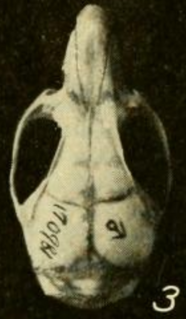Related Research Articles

Multituberculata is an extinct taxon of rodent-like allotherian mammals that existed for approximately 166 million years, the longest fossil history of any mammal lineage. They eventually declined from the late Paleocene onwards, disappearing from the known fossil record in the late Eocene, though gondwanatheres lived into the Miocene, and may have been multituberculates. More than 200 species are known, ranging from mouse-sized to beaver-sized. These species occupied a diversity of ecological niches, ranging from burrow-dwelling to squirrel-like arborealism to jerboa-like hoppers. Multituberculates are usually placed as crown mammals outside either of the two main groups of living mammals—Theria, including placentals and marsupials, and Monotremata—but closer to Theria than to monotremes. Nonetheless, at least one study found a potential status as sister taxa to monotremes/Australosphenida.

Lagenorhynchus is a genus in the order Cetacea, traditionally containing six species:

Micronycteris is a genus of leaf-nosed bats.

The Acaridae are a family of mites. Common forms include some mold mites, for example the grain mite. Genera in the family include:

Transandinomys bolivaris, also known as the long-whiskered rice rat, is a rodent in the genus Transandinomys. It is found in humid forest from northeastern Honduras to western Ecuador, up to 1,800 m (5,900 ft) above sea level. Since it was first described in 1901 from Ecuador, six scientific names have been introduced for it, but their common identity was not documented until 1998 and the species has long been known under the name Oryzomys bombycinus, described from Panama in 1912. The name Oryzomys bolivaris was used before it was moved to the new genus Transandinomys with Transandinomys talamancae in 2006.

Transandinomys talamancae is a rodent in the genus Transandinomys that occurs from Costa Rica to southwestern Ecuador and northern Venezuela. Its habitat consists of lowland forests up to 1,500 m (5,000 ft) above sea level. With a body mass of 38 to 74 g, it is a medium-sized rice rat. The fur is soft and is reddish to brownish on the upperparts and white to buff on the underparts. The tail is dark brown above and lighter below and the ears and feet are long. The vibrissae (whiskers) are very long. In the skull, the rostrum is long and the braincase is low. The number of chromosomes varies from 34 to 54.

The Tremellales are an order of fungi in the class Tremellomycetes. The order contains both teleomorphic and anamorphic species, most of the latter being yeasts. All teleomorphic species in the Tremellales are parasites of other fungi, though the yeast states are widespread and not restricted to hosts. Basidiocarps, when produced, are gelatinous.

Transandinomys is a genus of rodents in the tribe Oryzomyini of family Cricetidae. It includes two species—T. bolivaris and T. talamancae—found in forests from Honduras in Central America south and east to southwestern Ecuador and northwestern Venezuela in northern South America. Until 2006, its members were included in the genus Oryzomys, but phylogenetic analysis showed that they are not closely related to the type species of that genus, and they have therefore been placed in a new genus. They may be most closely related to genera like Hylaeamys and Euryoryzomys, which contain very similar species. Both species of Transandinomys have had eventful taxonomic histories.
The Macronyssidae are a family of parasitic mites in the order Mesostigmata.

The Laelapidae are a family of mites in the order Mesostigmata. The family is also referred to in the literature as Laelaptidae, which may be the correct spelling.

Dermanyssidae is a family of mites in the order Mesostigmata.

The McGovney–Yunker Farmstead is a historic farm in Mokena, Illinois.
Askinasia is a genus of mites in the family Acaridae.
Rhinoseius is a genus of mites in the family Ascidae.
Echinonyssus is a genus of mites in the family Laelapidae.
Lukoschus is a genus of mites in the family Laelapidae that was named after the German acarologist Fritz Lukoschus.
Uhlorchestia is a genus of beach hoppers in the family Talitridae. There are at least two described species in Uhlorchestia.

Bickham's little yellow bat is a species of vesper bat found in Central America.

Sachicasaurus is an extinct genus of brachauchenine pliosaurid known from the Barremian of the Paja Formation, Altiplano Cundiboyacense in the Colombian Eastern Ranges of the Andes. The type species is S. vitae.
References
- ↑ David Evans Walter (ed.). "Dasyponyssidae Species Listing". Biology Catalog. Texas A&M University . Retrieved September 3, 2010.CS1 maint: discouraged parameter (link)